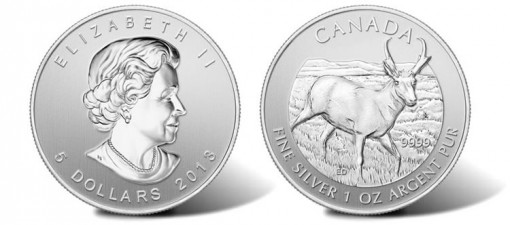Information is now available for the 2013 Pronghorn Antelope Silver Bullion Coin, the fifth of six issues in the popular Canadian Wildlife silver bullion coin series.

The Royal Canadian Mint unveiled the 2013-dated coin at the American Numismatic Association’s World’s Fair of Money Fair in Philadelphia, Pennsylvania on August 9, 2012.
Per the Mint’s news release, the pronghorn antelope is a true North American symbol, with herds of them live in areas stretching from southern Alberta and Saskatchewan in Canada all the way down to the Baja Peninsula and parts of Northern Mexico.
As expected, featured on the reverse of the bullion coin is an image of a Pronghorn Antelope walking in a field. It was drawn by Canadian artist and accomplished coinage designer Emily S. Damstra. Inscriptions include CANADA, FINE SILVER, 1 OZ, and ARGENT PUR. These elements surround the artwork. 9999 and ED for the coin’s purity and the artist’s initials are placed on either side of the antelope.
An effigy of Her Majesty Queen Elizabeth II, by Canadian artist Susanna Blunt, graces its obverse. Inscriptions are ELIZABETH II, 5 DOLLARS, and 2013.
This one ounce bullion coin will have a maximum mintage of one million, and it will be available through the Royal Canadian Mint’s global network of bullion distributors, including banks, coin dealers, foreign currency exchange offices, and brokerage houses. They are expected to be available by September.
Pricing of the 2013 Pronghorn Antelope Silver Bullion Coin will vary daily based on the international market rates of the precious metal it contains, which is exactly like pricing for the popular Canadian Maple Leaf. A reasonable premium has been added to cover the cost of manufacturing, transportation, and distribution.
One more coin in the Canadian Wildlife silver bullion coin series will be announced in early 2013 to complete the program. Previous issues were the 2011 dated coins featuring a wolf and a grizzly bear, followed by 2012’s cougar and moose coins.






I have all the coins in this series and will add this one. However not very impressed with any of the RCM coins as the milk spots really brings down the quality. The Perth Mint is the best mint in the world hands down. The creativity & quality is unmatched and I will continue to buy rolls/tubes from them and just single coins from everyone else.
I only have one maple leaf with milk spots. It is a regular 2006 maple leaf that I left in a plastic flip instead of a air tite capsule. All of my other Canadian coins are spotless. I immediately put them into an air tite..
I also read, over at silver stacker’s, that you can clean them. But I haven’t tried it.
Anyway, I love the wildlife series. What will be the final design?
My guess would be A Salmon, Polar Bear or a Goose.
Mark. I pay about $3 over spot at a dealer for quality coins when they first come out. I find the quality as good as the US Mint , maybe better.
Milk spots? Never heard of this. I’ve been getting the silver proof sets and don’t remember ever seeing “milk spots” or any other kind of spots on the coins. Maybe these spots are bullion coin related?
bill, How do you clean milk spots without takeing away the value of the coin? I have 3 Franklins with milk spots.
I think it is about the CQ S Mint quarter program from US Mint jim……I call it wash marks….
Joe……… LOL !!!!!
WHIZZING
The best method I know of for removing tarnish or spots is to boil water in a pan, put in a piece of aluminum foil and some baking soda. Then place the coins on the foil. This doesn’t damage the coins.
Use cotton gloves when handling all coins and place in protected capsules or sleeves. If storing, make sure you don’t have humidity issues, otherwise use a dehumidifier for the chamber.
Spotting is caused by tiny flakes of metal left over from the minting process that causes oxidation. Spotting, milky surfaces and flaking are the resulting visual and chemical change to a coins surface. These flakes can take awhile to oxidize and can be missed at the Mint’s Quality Control. I always suggest looking at your coins under magnification as soon as you receive them from a mint or prior to purchase from a coin shop. Cleaning is never recommended and if done incorrectly can damage the coin and the coins value. NGC (grading company) offers a cleaning service. I have… Read more »
this is where i had read about cleaning milk spots
http://forums.silverstackers.com/topic-29410-rcm-wildlife-series-5-pronghorn-antelope-page-1.html
but as i have stated before, i haven’t tried it
They use wipeys in Canada. Thanks bill. I’ll try it on a circulated Roosevelt silver dime. My daughter has some. It will look mint state by the time I get through with it.
Wow !! I’m glad I don’t buy stuff from y’all !!!
Big horn sheep